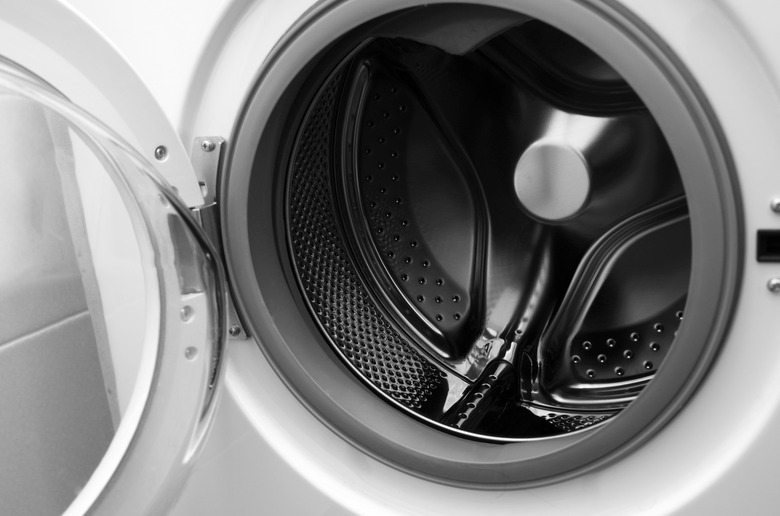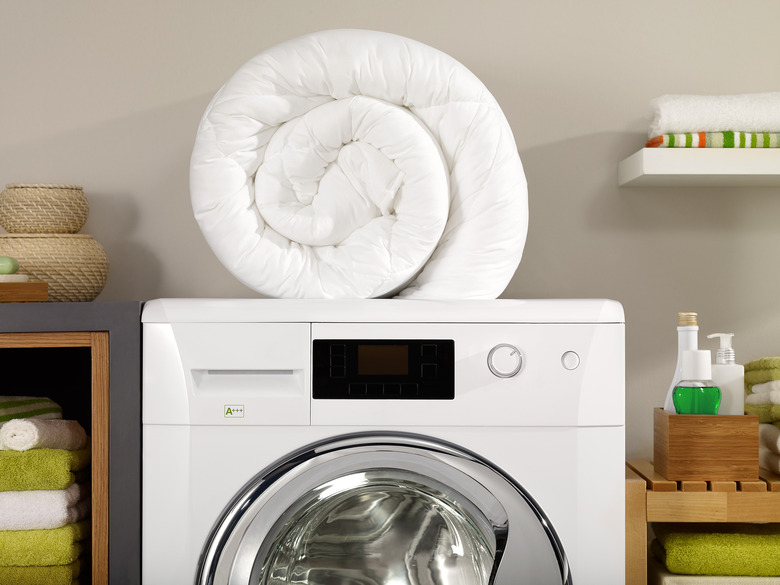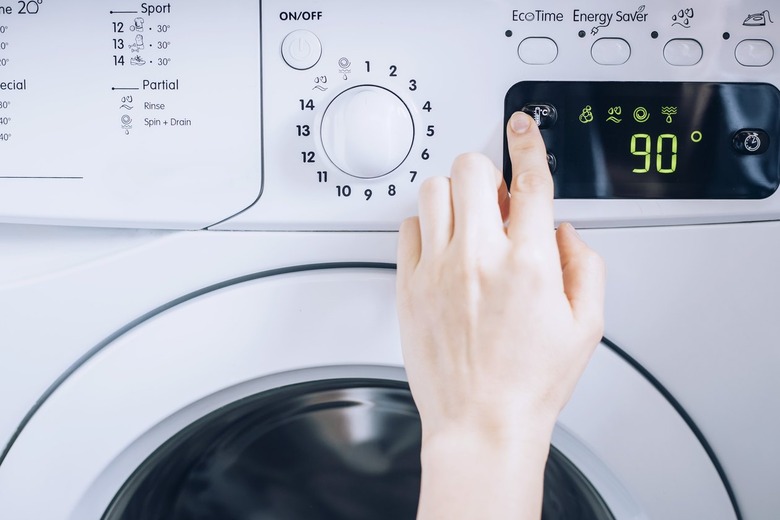How To Wash And Dry A Down Comforter, According To Cleaning Pros
We may receive a commission on purchases made from links.
Mother Nature typically knows best, so it's no wonder that nothing beats the warm yet breathable, fluffy yet weighted filling found in down comforters. Down is found beneath the exterior feathers on geese, swans, and ducks. It keeps the birds' core temperature consistent in frigid temperatures, and it's one of the best materials for cuddling in your bed on a cold night.
For all its benefits, down requires some extra care and maintenance when keeping it clean; otherwise, you risk damaging its fragile structure. Many manufacturers recommend hiring a professional launderer or dry cleaner to wash a down comforter. This can, of course, get pricey and time-consuming, so we turned to the experts to learn exactly how to wash a down comforter at home.
Cleaning Down vs. Down Alternative
Cleaning Down vs. Down Alternative
A comforter's cleaning and care routine is largely going to depend on one thing: the stuffing on the inside. Down can come from geese, swans, or ducks, but it's not the feathers of these birds. Down is the fluffy clusters found beneath the feathers, or the undercoat, in the chest and underbelly area of the birds. Because you know your down comforter only has down in it (at least mostly — down comforters sold in the U.S. must be at least 75 percent down to earn the name), the simple materials demystify the washing process. On the other hand, down alternative is created to mimic the soft, luxurious feel and weight of down without the luxury price point or the use of animal products. A down alternative comforter can be made from synthetic materials, like polyester, microfiber, and PrimaLoft, or from natural fillers, like cotton, silk, and wool.
As far as how to wash each type, there are a few differences. A gentle approach will protect your down comforter through the washing process. For best results when washing a down comforter, use a front-loading washer with a capacity large enough to properly fit the blanket (a top-loading washer has an agitator, which could potentially rip and damage the comforter). Use a mild detergent, preferably a down-safe detergent, and ditch the fabric softeners. Select the gentle cycle and consider an extra rinse cycle to get rid of any lingering detergent.
With so many possible materials in play, it's necessary to check the down alternative comforter's care label before tossing it in the washing machine. While down alternative is typically machine washable, the label will specify the proper cleaning methods to keep your down alternative comforter in top quality. Like a down comforter, though, refrain from using a top-loading washer or dryer if possible.
Tip
Always check the care label of any comforter regardless if it's down or down alternative. The label will provide proper care instructions.
Is the Washer Big Enough?
Is the Washer Big Enough?
Just because you can stuff your comforter into your washer doesn't mean you should. Cramming your down comforter into a too-small washing machine drum can damage the comforter and even wreck the washer. And top-loader washers should generally be avoided no matter what capacity they have. If you use a top-loading washer, you risk ruining the down comforter if it becomes stretched around the agitators. Further, there's a likelihood that the down comforter would not be fully cleaned.
"I do not recommend using a top-loader washer, as the comforter will just sit in the dirty water," Wayne Edelman, CEO of Meurice Garment Care and CLEAN by Meurice, tells Hunker. "A front loader is best, and it needs to be sized correctly so the comforter occupies 2/3 of the wash wheel when put in."
When the comforter is placed in a front-loading washer with extra space, the wet part of the comforter has room to fall onto any dry parts of the comforter when the washer switches directions. When there's no extra allotted space, the comforter won't be fully cleaned.
So, how big is big enough? According to tests run by Consumer Reports, a washer with a capacity of 4.5 cubic feet will fit a king-size down comforter. Of course, you can always use the large, commercial washers at the local laundromat if your household washer capacity isn't up to par.
As far as drying goes, Hugo Guerrero, certified house cleaning technician and consultant at Mattressive, recommends using a dryer with a drum capacity of 7 cubic feet. You'll need more room in the dryer than the washer because the down comforter will expand as it dries.
When to Wash a Comforter
When to Wash a Comforter
Ask a crowd when to wash a down comforter, and you'll get many different answers. Monthly? Weekly? When you need to remove a stain? When the comforter starts to stink? Here's what the experts say.
According to Guerrero, a down comforter only needs washing every one to two years if the down comforter:
- Is kept in a clean room that doesn't get slept in very frequently (like a guest room)
- Doesn't come in contact with pets
- Is protected by a duvet
However, the down comforter cover that protects the comforter from nightly sweat, oil, and dust mites should be washed much more regularly: about once a month.
Choosing a Washing Temperature
Choosing a Washing Temperature
Choosing the wrong washing temperature can wreak havoc on a down comforter. "Hot water (above 60 degrees Celsius or 140 degrees Fahrenheit) can shrink the fabric and damage the down feathers," Guerrero tells Hunker. "Cold water is not recommended, as it may not effectively remove dirt and stains."
The sweet spot for the down comforter washing temperature, Guerrero reveals, is in warm water that's around 86 to 104 degrees Fahrenheit.
When Washing Down Goes Wrong
When Washing Down Goes Wrong
If you want to enjoy the soft, insulating, fluff of down for many years to come, then you'll need to deal with its slightly high-maintenance wash routine. Here's what can happen when the down comforter isn't washed according to its particular preferences:
The Comforter Can Become Lumpy
Fabric softeners should be totally avoided. While it may make some other clothes softer, fabric softeners coat down fibers and cause them to clump together. Edelman explains that letting the comforter dry in the dryer without using dryer balls and without redistributing the down can result in a lumpy down comforter as well.
Mildew Can Develop
This can result from an air-dried comforter or a comforter that was only partially dried in the dryer. Never air dry down due to the potential risk of mold and mildew, and make sure that the dryer is large enough to fully dry the comforter.
Odors Can Form
Foul odor can mean a couple of things. It could indicate the presence of mildew because the comforter was improperly dried, or if the down comforter was washed in a too-small washer, then it was not actually cleaned.
Disintegrating Fibers
"If the comforter is washed in too-hot water or dried on too-high heat, it can cause damage to the comforter, making it less durable," Guerrero says. Additionally, using bleach at any point in the cleaning process can harm and deteriorate the down.
No Longer Insulating
A down comforter's insulating properties depend on the down's loft. Using too much detergent can compromise the down's loft, according to Edelman, decreasing the comforter's fill power and its warmth.
The Fabric Can Shrink
Frequently drying your down comforter can cause it to shrink around 3 to 5 percent, which can be noticeable if it makes your down comforter a tad too small of your bed or duvet cover.
The Comforter Can Become Matted
Down is fluffy, but if you store it in an airtight bag or regularly lie on top of your down comforter, it will become compressed over time.
How to Wash a Down Comforter
How to Wash a Down Comforter
Here's your comprehensive step-by-step guide to washing a down comforter:
1. Pretreat Down Comforter Stains
"Lay the comforter out and use a pretreatment spray with a gentle brush on stains. Or, make a mixture of some detergent and water and use that mixture with a brush as a pretreatment," says Edelman.
2. Wash With the Proper Detergent
Go as gentle as possible when choosing a detergent for a down comforter. This means skipping any bleach, fragrances, dyes, and fabric softeners. Choose a detergent made specifically for down as opposed to a strong laundry detergent that can damage down fibers.
3. Use the Gentle Cycle
Make sure the comforter can move freely in the washer. If you're breaking a sweat trying to make it fit, then there's no chance that the comforter will actually get clean.
It's OK to add an extra rinse cycle to the washer or even an entirely new wash cycle with no soap added. Making sure all the detergent is rinsed out of the down comforter will help keep it fluffy and warm after drying.
4. Expect an Odor
If your comforter smells a bit musty, don't try to clean it again with a fragrance detergent. Remember that down is a natural animal product, and it will have an odor whenever it gets wet. The smell should dissipate as it dries in the dryer.
5. Drying the Down Comforter
Go into the drying process with the understanding that this process, when done correctly, likely takes several hours and some intervention on your part.
First, as with the washer, make sure the dryer is an appropriate size: about 7 cubic feet for a king-size down comforter. Insert the down comforter. Guerrero recommends adding a few clean tennis balls or wool dryer balls to mitigate clumping.
Use the lowest possible heat setting (this will likely be the delicate cycle). Letting the down comforter get too hot can actually burn the delicate down.
Near the end of the drying cycle, take the down comforter out of the dryer and give it a few shakes. "Check for feather 'clumping,' which can be broken up by hand, then continue drying," Edelman advises.
Make sure the down comforter is entirely dry to prevent mold, mildew, and foul odor.
6. Provide Comforter Maintenance
When you place your refreshed down comforter on the bed, protect it from oils, sweat, and surface stains with a duvet cover and a top sheet. If possible, refrain from placing heavy objects on the comforter for long periods of time or from lounging on it frequently.
With proper care, your down comforter can keep you warm and comfortable for a couple of decades to come.




